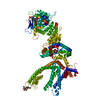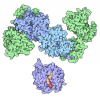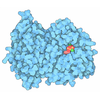[English] 日本語
 Yorodumi
Yorodumi- EMDB-61525: Nematostella vectensis TRPM2 protomer in complex with ADPRP/Ca2+ -
+ Open data
Open data
- Basic information
Basic information
| Entry |  | |||||||||
|---|---|---|---|---|---|---|---|---|---|---|
| Title | Nematostella vectensis TRPM2 protomer in complex with ADPRP/Ca2+ | |||||||||
 Map data Map data | ||||||||||
 Sample Sample |
| |||||||||
 Keywords Keywords | Nematostella vectensis / TRPM2 / ADPRP / Ca2+ / MEMBRANE PROTEIN | |||||||||
| Function / homology |  Function and homology information Function and homology informationADP-ribose diphosphatase activity / ligand-gated calcium channel activity / ligand-gated sodium channel activity / sodium ion transmembrane transport / calcium ion transmembrane transport / metal ion binding / plasma membrane Similarity search - Function | |||||||||
| Biological species |  Nematostella vectensis (starlet sea anemone) Nematostella vectensis (starlet sea anemone) | |||||||||
| Method | single particle reconstruction / cryo EM / Resolution: 2.65 Å | |||||||||
 Authors Authors | Jiang Y / Zhang Z / Toth B / Szollosi A / Csanady L | |||||||||
| Funding support |  China, 2 items China, 2 items
| |||||||||
 Citation Citation |  Journal: Proc Natl Acad Sci U S A / Year: 2024 Journal: Proc Natl Acad Sci U S A / Year: 2024Title: A conserved mechanism couples cytosolic domain movements to pore gating in the TRPM2 channel. Authors: Balázs Tóth / Yuefeng Jiang / Andras Szollosi / Zhe Zhang / László Csanády /   Abstract: Transient Receptor Potential Melastatin 2 (TRPM2) cation channels contribute to immunocyte activation, insulin secretion, and central thermoregulation. TRPM2 opens upon binding cytosolic Ca and ADP ...Transient Receptor Potential Melastatin 2 (TRPM2) cation channels contribute to immunocyte activation, insulin secretion, and central thermoregulation. TRPM2 opens upon binding cytosolic Ca and ADP ribose (ADPR). We present here the 2.5 Å cryo-electronmicroscopy structure of TRPM2 from (nvTRPM2) in a lipid nanodisc, complexed with Ca and ADPR-2'-phosphate. Comparison with nvTRPM2 without nucleotide reveals that nucleotide binding-induced movements in the protein's three "core" layers deconvolve into a set of rigid-body rotations conserved from cnidarians to man. By covalently crosslinking engineered cysteine pairs we systematically trap the cytosolic layers in specific conformations and study effects on gate opening/closure. The data show that nucleotide binding in Layer 3 disrupts inhibitory intersubunit interactions, allowing rotation of Layer 2 which in turn expands the gate located in Layer 1. Channels trapped in that "activated" state are no longer nucleotide dependent, but are opened by binding of Ca alone. | |||||||||
| History |
|
- Structure visualization
Structure visualization
| Supplemental images |
|---|
- Downloads & links
Downloads & links
-EMDB archive
| Map data |  emd_61525.map.gz emd_61525.map.gz | 127.1 MB |  EMDB map data format EMDB map data format | |
|---|---|---|---|---|
| Header (meta data) |  emd-61525-v30.xml emd-61525-v30.xml emd-61525.xml emd-61525.xml | 15.8 KB 15.8 KB | Display Display |  EMDB header EMDB header |
| Images |  emd_61525.png emd_61525.png | 95 KB | ||
| Filedesc metadata |  emd-61525.cif.gz emd-61525.cif.gz | 6.7 KB | ||
| Others |  emd_61525_half_map_1.map.gz emd_61525_half_map_1.map.gz emd_61525_half_map_2.map.gz emd_61525_half_map_2.map.gz | 124.9 MB 124.8 MB | ||
| Archive directory |  http://ftp.pdbj.org/pub/emdb/structures/EMD-61525 http://ftp.pdbj.org/pub/emdb/structures/EMD-61525 ftp://ftp.pdbj.org/pub/emdb/structures/EMD-61525 ftp://ftp.pdbj.org/pub/emdb/structures/EMD-61525 | HTTPS FTP |
-Related structure data
| Related structure data |  9jjfMC  9jjeC M: atomic model generated by this map C: citing same article ( |
|---|---|
| Similar structure data | Similarity search - Function & homology  F&H Search F&H Search |
- Links
Links
| EMDB pages |  EMDB (EBI/PDBe) / EMDB (EBI/PDBe) /  EMDataResource EMDataResource |
|---|---|
| Related items in Molecule of the Month |
- Map
Map
| File |  Download / File: emd_61525.map.gz / Format: CCP4 / Size: 134.6 MB / Type: IMAGE STORED AS FLOATING POINT NUMBER (4 BYTES) Download / File: emd_61525.map.gz / Format: CCP4 / Size: 134.6 MB / Type: IMAGE STORED AS FLOATING POINT NUMBER (4 BYTES) | ||||||||||||||||||||||||||||||||||||
|---|---|---|---|---|---|---|---|---|---|---|---|---|---|---|---|---|---|---|---|---|---|---|---|---|---|---|---|---|---|---|---|---|---|---|---|---|---|
| Projections & slices | Image control
Images are generated by Spider. | ||||||||||||||||||||||||||||||||||||
| Voxel size | X=Y=Z: 1.07 Å | ||||||||||||||||||||||||||||||||||||
| Density |
| ||||||||||||||||||||||||||||||||||||
| Symmetry | Space group: 1 | ||||||||||||||||||||||||||||||||||||
| Details | EMDB XML:
|
-Supplemental data
-Half map: #2
| File | emd_61525_half_map_1.map | ||||||||||||
|---|---|---|---|---|---|---|---|---|---|---|---|---|---|
| Projections & Slices |
| ||||||||||||
| Density Histograms |
-Half map: #1
| File | emd_61525_half_map_2.map | ||||||||||||
|---|---|---|---|---|---|---|---|---|---|---|---|---|---|
| Projections & Slices |
| ||||||||||||
| Density Histograms |
- Sample components
Sample components
-Entire : nvTRPM2 protomer in complex with ADPRP/Ca2+
| Entire | Name: nvTRPM2 protomer in complex with ADPRP/Ca2+ |
|---|---|
| Components |
|
-Supramolecule #1: nvTRPM2 protomer in complex with ADPRP/Ca2+
| Supramolecule | Name: nvTRPM2 protomer in complex with ADPRP/Ca2+ / type: complex / ID: 1 / Parent: 0 / Macromolecule list: #1 |
|---|---|
| Source (natural) | Organism:  Nematostella vectensis (starlet sea anemone) Nematostella vectensis (starlet sea anemone) |
| Molecular weight | Theoretical: 170 KDa |
-Macromolecule #1: Transient receptor potential cation channel subfamily M member-like 2
| Macromolecule | Name: Transient receptor potential cation channel subfamily M member-like 2 type: protein_or_peptide / ID: 1 / Number of copies: 1 / Enantiomer: LEVO |
|---|---|
| Source (natural) | Organism:  Nematostella vectensis (starlet sea anemone) Nematostella vectensis (starlet sea anemone) |
| Molecular weight | Theoretical: 176.663438 KDa |
| Recombinant expression | Organism:  Homo sapiens (human) Homo sapiens (human) |
| Sequence | String: MGKDSFTPLY DGGDSSHVHL NKFGSNQLSQ SKKSWIARNF SRRECIRFVP KSHDVSRCKC GRPRERHSQQ ALESGQGSEE WNVASCTTK HPTNAYGEID FEGYGGQKRA PYLRMSHDTD ANLVITLMLK RWNLEIPNLV ISVTGGAKSF VLKPRLREMF R RGLIKAAK ...String: MGKDSFTPLY DGGDSSHVHL NKFGSNQLSQ SKKSWIARNF SRRECIRFVP KSHDVSRCKC GRPRERHSQQ ALESGQGSEE WNVASCTTK HPTNAYGEID FEGYGGQKRA PYLRMSHDTD ANLVITLMLK RWNLEIPNLV ISVTGGAKSF VLKPRLREMF R RGLIKAAK TTGAWIITGG TNTGVMKHVG EAVKEQQLMF GSDTQVNVIG IATWGIVDKQ SDLISEKNGK YPALYSMEPT PG HQGAMLD PNHSHFFLVD DGTEGKYGVE IGMRSRIEEA IMKVKTDSRS EAGSIGVPVV LLVLEGGPNT VATMYELIKK KVP AVVIDG SGRAASVVGF AYNHTIKRNV DGQTINVIDP QYEDEVRAKV VEVFGAKGAD KTYSMIKDVL EDEKMISVYS LDGE ISQDI DLAILKALLK ANRSSPVAQL NLALAWNRID LAKSDIFTEE QQWTTETLSA AMLTALLDDK AEFAELFLQN GLSMR EFLS LDILCKLYAE VPGNTTIKPL LQKEMGKRQV KTIDMDVVGE VIEELMGDMF ESYYRKDGHY FGELASYAEG LVLKNR KSS KDLLANINRI DPLPTPYLDV FLWAVLCNRR ELARVLWEAG REPMAAALMA SRLLKRMASR AQEDNTITDI SSDLYDH AR LFEERAVGVL DECFNENETL SQTLLVRELD HYSRMTALEL AVSAESQDFI AHTSCQVLLT RLWMGTMAMN TRWWKVLV C LYLPVLIFPI IYFVPDEQHE RQAAEREHQK SLNQKSSKVK SHKEKNDAPV VPVYRSKEEK AVSNDEEARV GTENEEEDF QLEDYIPEIR EDDSMEVIMR NKKLGFCDRI MHFYSAPFSK FVGNVVGYLA FIFLYAYVVL FNFPRFDPAK TLGGIHPTEI VLYFWVFTI LIEEIRQLAA KPPKYIKDKV SVYFSDTWNF VDIFSLTVFI IAIILRFFTN SRIFTASRII LSLDIIFFIV R SLQIFSVN RLLGPKLVMI QKMMQDLAQF IIILAVFTIA YGIALHAVMF PSPGIYARNN TWVTITSVVQ YPYWQMYGEL FL DEIQGEK PKEFGEVDPD GRWLSPLLLA IYMVFTNILL LNLLIAIFNY TFERVQEDSD KVWKFQRYDL VQEYHSRPVF APP LVLLGH ILIFIRWVWR MCRCGHPPRG STMKIGLSPA EMEQMDNWEF QAAEMYIHQQ QQKNSGTLEE RVRALGDRVD CINS QLNRV LDSMSGTRAH ALTDGNGLEG GHDSEGRLAR MEVELSSNSE SLQKILALLQ QQPPVKGQAA VPIQLTLLHY KARSS PYPG STAKRFAVQD NMVDWQVPFP DYKPVNYTAP VVLANPVWAD KDLMAMSPRP ELPYNQMDHT CNVNRVSYNG TYVVKD GLP LNPMGRTGMQ GRGLLGRFGP NHAADPVVTR WKRTSAGVML QGGKKVLEFV AIQRKDNNQW AIPGGMVEPG QLVTQAL KA EFGEEAMAKL NVSQEEKERI AKQIERLFQQ GQEIYKGYVD DPRNTDNAWM ETVAVNFHDD KGDLFGDITL QAGDDAAA V RWQRVSGNIP LYASHVSILE KVAKMRDAAF SNSLEVLFQ UniProtKB: Transient receptor potential cation channel subfamily M member-like 2 |
-Macromolecule #3: CALCIUM ION
| Macromolecule | Name: CALCIUM ION / type: ligand / ID: 3 / Number of copies: 1 / Formula: CA |
|---|---|
| Molecular weight | Theoretical: 40.078 Da |
-Macromolecule #4: [(2R,3R,4R,5R)-5-(6-AMINO-9H-PURIN-9-YL)-3-HYDROXY-4-(PHOSPHONOOX...
| Macromolecule | Name: [(2R,3R,4R,5R)-5-(6-AMINO-9H-PURIN-9-YL)-3-HYDROXY-4-(PHOSPHONOOXY)TETRAHYDROFURAN-2-YL]METHYL [(2R,3S,4R,5R)-3,4,5-TRIHYDROXYTETRAHYDROFURAN-2-YL]METHYL DIHYDROGEN DIPHOSPHATE type: ligand / ID: 4 / Number of copies: 1 / Formula: A2R |
|---|---|
| Molecular weight | Theoretical: 639.296 Da |
| Chemical component information |  ChemComp-A2R: |
-Experimental details
-Structure determination
| Method | cryo EM |
|---|---|
 Processing Processing | single particle reconstruction |
| Aggregation state | particle |
- Sample preparation
Sample preparation
| Concentration | 6 mg/mL |
|---|---|
| Buffer | pH: 8 |
| Vitrification | Cryogen name: ETHANE |
- Electron microscopy
Electron microscopy
| Microscope | FEI TITAN KRIOS |
|---|---|
| Image recording | Film or detector model: GATAN K3 (6k x 4k) / Average electron dose: 60.0 e/Å2 |
| Electron beam | Acceleration voltage: 300 kV / Electron source:  FIELD EMISSION GUN FIELD EMISSION GUN |
| Electron optics | Illumination mode: FLOOD BEAM / Imaging mode: BRIGHT FIELD / Nominal defocus max: 2.2 µm / Nominal defocus min: 1.0 µm |
| Experimental equipment |  Model: Titan Krios / Image courtesy: FEI Company |
- Image processing
Image processing
| Startup model | Type of model: NONE |
|---|---|
| Final reconstruction | Resolution.type: BY AUTHOR / Resolution: 2.65 Å / Resolution method: FSC 0.143 CUT-OFF / Number images used: 474307 |
| Initial angle assignment | Type: ANGULAR RECONSTITUTION |
| Final angle assignment | Type: ANGULAR RECONSTITUTION |
 Movie
Movie Controller
Controller






 Z (Sec.)
Z (Sec.) Y (Row.)
Y (Row.) X (Col.)
X (Col.)




































